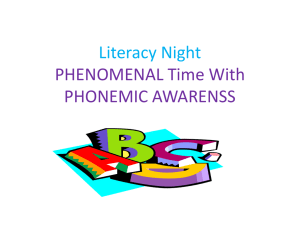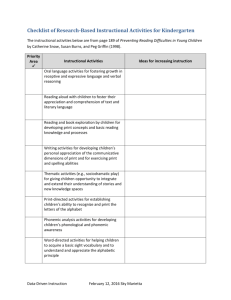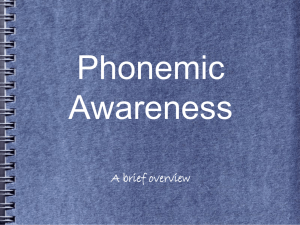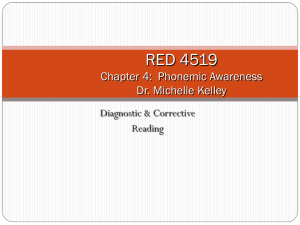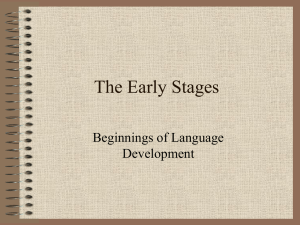Kindergarten and Preschool Shared Reading, Guided Reading
advertisement
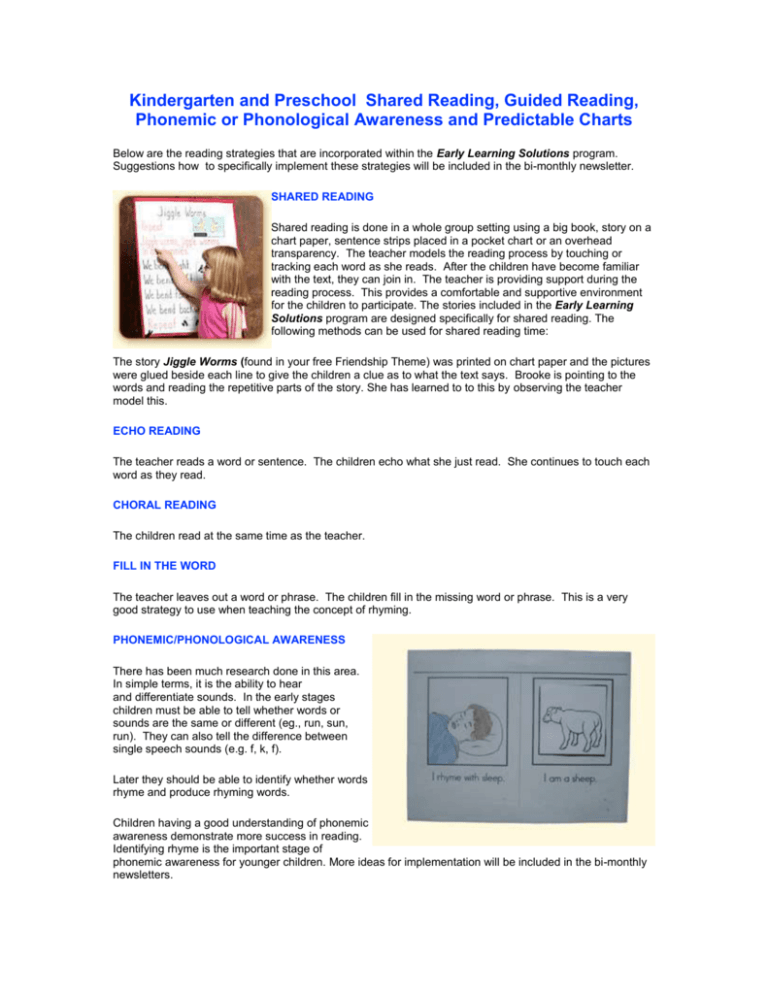
Kindergarten and Preschool Shared Reading, Guided Reading, Phonemic or Phonological Awareness and Predictable Charts Below are the reading strategies that are incorporated within the Early Learning Solutions program. Suggestions how to specifically implement these strategies will be included in the bi-monthly newsletter. SHARED READING Shared reading is done in a whole group setting using a big book, story on a chart paper, sentence strips placed in a pocket chart or an overhead transparency. The teacher models the reading process by touching or tracking each word as she reads. After the children have become familiar with the text, they can join in. The teacher is providing support during the reading process. This provides a comfortable and supportive environment for the children to participate. The stories included in the Early Learning Solutions program are designed specifically for shared reading. The following methods can be used for shared reading time: The story Jiggle Worms (found in your free Friendship Theme) was printed on chart paper and the pictures were glued beside each line to give the children a clue as to what the text says. Brooke is pointing to the words and reading the repetitive parts of the story. She has learned to to this by observing the teacher model this. ECHO READING The teacher reads a word or sentence. The children echo what she just read. She continues to touch each word as they read. CHORAL READING The children read at the same time as the teacher. FILL IN THE WORD The teacher leaves out a word or phrase. The children fill in the missing word or phrase. This is a very good strategy to use when teaching the concept of rhyming. PHONEMIC/PHONOLOGICAL AWARENESS There has been much research done in this area. In simple terms, it is the ability to hear and differentiate sounds. In the early stages children must be able to tell whether words or sounds are the same or different (eg., run, sun, run). They can also tell the difference between single speech sounds (e.g. f, k, f). Later they should be able to identify whether words rhyme and produce rhyming words. Children having a good understanding of phonemic awareness demonstrate more success in reading. Identifying rhyme is the important stage of phonemic awareness for younger children. More ideas for implementation will be included in the bi-monthly newsletters. Note: In the members' area you will find many rhyming emergent reader printable books like the one above. They have been specifically designed for shared reading, phonemic awareness and guided reading. There are also many picture rhyming cards and suggested activities to further develop phonemic awareness with young learners. There is over 65 theme related emergent readers included in the members' area. These are wonderful to use for shared or guided reading. The page above is found in the mini-Farm theme. The text reads: I rhyme with sleep. The children must locate, cut and paste the rhyming farm animal that rhymes (I am a sheep). PREDICTABLE CHARTS These are generated by the teacher or the children. The teacher uses these charts to model reading and writing experiences. A repetitive phrase is chosen and the teacher prints what she has generated or what a child has dictated and this is printed on a chart paper or sentence strips. The chart above was taken from the emergent reader found in the Community Helpers theme unit This is only a portion of the reader. The children must find, cut and paste the correct vehicle each helper uses. This is the interactive component part of the reader. Some of the text lines read as follows: I could be a firefighter. I would drive a fire truck. I could be a police officer. I would drive a police car. PREDICTABLE CHART - VISUAL and AUDITORY DISCRIMINATION A predictable chart could also be employed by children dictating the sentences. For example: John says, "I want to be a paramedic". The teacher prints this on the predictable chart with John's name beside it. John would be responsible for reading this sentence. Predictable chart experiences can be easily transferred to the writing center. Children represent the repetitive words in the predictable chart. Place the repetitive words on a 8 1/2 X 11 piece of paper. One child holds the word I, another child holds the word would and another one holds the word like and so on . John dictates 'I would like to be a Firefighter.' The teacher prints the word on the last piece of paper. She might model stretching the sounds F-i-r-e-f-i-g-h-t-e-r-s as she prints it. She might also discuss capitals and periods used in completing the sentence. She is indirectly teaching writing skills. John holds his own word which is Firefighter. The children now can read John's completed sentence. This is a great phonemic awareness activity. The children are learning how words are separated by spaces and what makes a sentence.This is an excellent visual and auditory discrimination activity. More Information on Shared Reading Click on the links below to read my blog for more information on shared reading. More Information on Shared Reading Shared Reading Daily Plan WRITING CENTER - MAKING SENTENCES The teacher has cut the words I would like to be a in an envelope. She will now add the word firefighter. The sentence I would like to be a firefighter has been scrambled. John now goes to the writing center and unscrambles the words and then he glues them on a piece of paper. He will then illustrate what the text says. All the children in the class can do this activity. The completed sheets could be compiled and made into a class book. This activity is a great phonemic awareness experience. This can be incorporated using any repetitive or predictable story. Younger children can use a model to complete the project . REPETITION IN READING A STORY The stories within the theme units are intended to be read in a shared reading experience each day for the duration of a week. The more times the children read the story with teacher support the more comfortable they will become in attempting to read it on their own, which we will call pretend reading (because they are not actually reading it on their own yet). This is building a foundation for future reading success by helping children gain confidence in it and the process involved. Even though the story is read each day for a week, the follow-up activities can vary bringing more meaning to the story. I have used the story Dogs, Dogs which is in the Family and Pets theme unit as an example of extended follow-up activities that can be used. The newsletter provides more ideas. 1. The children act out different parts of the story. The story is about how to look after a dog. The children can choose one of these to act out to the rest of the class. Other classmates can guess what part of the story they are acting out. 2. The interactive component in the story requires the children to draw or cut out a dog. Present drawing lessons on how to do this (an artistic child is a valuable resource for this). 3. Children bring in pictures or their real pet to share with the class. Discuss what they do to look after them. 4. Visit a Pet Store 5. Discuss pets and have the children predict what pet is the most common within the classroom. A picture graph could be made to confirm their predictions. 6. Complete a craft like the one shown above depicting how to look after a dog. Note: Templates to complete the craft are found in the members' area. TEACH CHILDREN GUIDED READING Guided reading is different from shared reading because it is done in a small group setting. The teacher works with a small group of children, focusing on specific skills. The teacher may focus on the children tracking words, identifying sight words or blending sounds. Books used for this purpose are called emergent readers because they have predictable text. The photograph shown above was taken from the "Community Helpers" theme unit. The text is predictable and repetitive making it easy for younger learners to be successful in their first reading experiences. There are over 80 printable theme-related emergent readers found in the member's area. These are great for guided reading as they can be copied and used for each member of the group.
